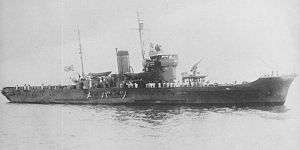Tsubame-class minelayer
 Tsubame in April 1929 | |
| Class overview | |
|---|---|
| Name: | Tsubame class minelayer |
| Builders: | |
| Operators: |
|
| Preceded by: | Sokuten-class |
| Succeeded by: | Natsushima-class |
| Built: | 1928–1929 |
| In commission: | 1929–1945 |
| Planned: | 2 |
| Completed: | 2 |
| Lost: | 2 |
| General characteristics | |
| Type: | Netlayer/Minelayer |
| Displacement: | 450 long tons (457 t) standard |
| Length: | 68.80 m (225 ft 9 in) overall |
| Beam: | 7.20 m (23 ft 7 in) |
| Draught: | 2.10 m (6 ft 11 in) |
| Propulsion: |
|
| Speed: | 19.0 knots (21.9 mph; 35.2 km/h) |
| Range: | 1,200 nmi (2,200 km) at 10 kn (12 mph; 19 km/h) |
| Complement: | 43 |
| Armament: |
|
The Tsubame class minelayer (燕型敷設艇, Tsubame-gata Fusetsutei) was a class of minelayers of the Imperial Japanese Navy (IJN), serving during and after 1929 through World War II.
Ships in class
Tsubame (燕)
- 17 September 1928: Laid down as the Capture netlayer (捕獲網艇 Hokakumōtei) at Yokohama Dock Company.
- 22 March 1929: Reclassified to 2nd class minelayer (二等敷設艇 Nitō-Fusetsutei).
- 24 April 1929: Launched.
- 10 July 1929: Completed.
- 30 May 1931: Reclassified to Special service ship (特務艇 Tokumutei).
- In 1936: Rebuilding by the Tomozuru Incident at Sasebo Naval Arsenal.
- In 1938: Sortie for the Second Sino-Japanese War.
- 18 December 1941: Sortie for the invasion of the Lingayen Gulf.
- (after): She spent all her time on convoy escort operations in East China Sea and Java Sea.
- 1 February 1944: Reclassified to Minelayer (敷設艇 Fusetsutei).
- 1 March 1945: Sunk by air raid from U.S. Navy aircraft carrier at Ishigaki Island.
- 10 May 1945: Removed from Navy List.
Kamome (鷗)
- 11 October 1928: Laid down as the Capture netlayer at Ōsaka Iron Works.
- 22 March 1929: Reclassified to 2nd class minelayer.
- 27 April 1929: Launched.
- 30 August 1929: Completed.
- 30 May 1931: Reclassified to Special service ship.
- In 1936: Rebuilding by the Tomozuru Incident at Sasebo Naval Arsenal.
- In 1938: Sortie for the Second Sino-Japanese War.
- 18 December 1941: Sortie for the invasion of the Lingayen Gulf.
- (after): She spent all her time on convoy escort operations in East China Sea, South China Sea and Java Sea.
- 1 February 1944: Reclassified to Minelayer.
- 27 April 1944: Sunk by USS Halibut at north off Naha 27°37′N 128°11′E / 27.617°N 128.183°E.
- 10 June 1944: Removed from Navy List.
Photos
 Kamome in 1929
Kamome in 1929
Bibliography
- Ships of the World special issue Vol.45, Escort Vessels of the Imperial Japanese Navy, "Kaijinsha". , (Japan), February 1996
- The Maru Special, Japanese Naval Vessels No.47, Japanese naval mine warfare crafts, "Ushio Shobō". (Japan), January 1981
This article is issued from
Wikipedia.
The text is licensed under Creative Commons - Attribution - Sharealike.
Additional terms may apply for the media files.